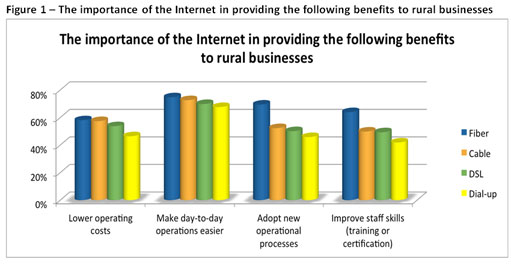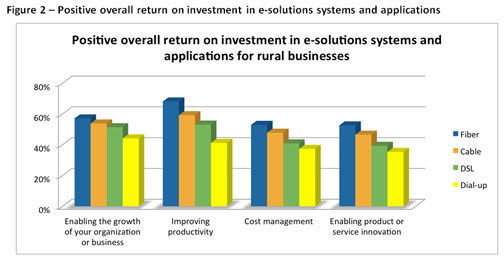Internet Innovation Alliance, 24 August 2011

Internet Innovation Alliance, 24 August 2011

Sources
1
— Source: Federal Communications Commission, www.broadband.gov, Accessed 6/24/11
“The Bureau of Labor Statistics forecasts that jobs depending on broadband and information and communication technologies (ICT)—such as computer systems analysts, database administrators and media and communications workers—will grow by 25% from 2008–2018, 2.5 times faster than the average across all occupations and industries.”
2
— Source: Joelle Tessler, “Broadband Funding In Stimulus Plan Sparks Debate,” The Associated Press, 2/6/09
“These investments will create new jobs up and down the economic food chain, said Robert Atkinson, president of the Information Technology and Innovation Foundation. His group estimates that a $10 billion investment in broadband would produce as many as 498,000 new jobs. Those include the construction workers and telecommunications technicians who must dig up streets, lay down fiber-optic lines and install wireless towers, as well as the engineers and factory workers at companies that make the fiber, electronics and computer equipment needed to build the networks. Much of that equipment is made overseas now, but Atkinson’s projections exclude jobs that would go abroad.”
3
— Source: Strategic Networks Group, “e-NC and SNG Release Broadband Findings for North Carolina,” 10/28/11 https://sngroup.com/e-nc-and-sng-release-broadband-findings-for-north-carolina/
“Nearly one in five (18%) of new jobs were created as a direct result of Broadband Internet.”
4
— Source: Twin Cities Daily Planet, “Building Broadband Infrastructure for Jobs in Greater Minnesota,” 5/24/11, http://www.tcdailyplanet.net/news/2011/05/24/building-broadband-infrastructure-jobs-greater-minnesota
“…17% of retirees, nearly three out of five unemployed adults, and almost one-third of homemakers say they would likely join the workforce if empowered to do so by teleworking.”
5
— Source: Strategic Networks Group. “Measuring Broadband’s Impact,” https://sngroup.com/broadband-lifecycle/measuring-the-impact-of-broadband/ Accessed 07/26/11
“We have demonstrated that the local economic growth and secondary investment enabled by broadband in 10 times the initial broadband investment and the contribution to Gross Domestic Product (GDP) is 15 times the initial investment.”
6
— Source: Federal Communications Commission, www.broadband.gov, Accessed 6/24/11
“Broadband is becoming a prerequisite to economic opportunity for individuals, small businesses and communities. Those without broadband and the skills to use broadband-enabled technologies are becoming more isolated from the modern American economy. This is due in part to the rapidly changing nature of work in the digital age. Sixty-two percent of American workers rely on the Internet to perform their jobs.”
7
— Source: 2008 Robert Half International, http://www.teleworkresearchnetwork.com/telecommuting-statistics, Accessed 7/8/11
“72% of employees say flexible work arrangements would cause them to choose one job over another. 37% specifically cite telecommuting.”
8
— Source: 2009 National Technology Readiness Survey Telecommuting Report, http://www.technoreadymarketing.com/NTRS_2009_Telecommuting_Cost.php, Accessed 7/8/11
“…14 percent telecommute or work at home, of which half (7 percent) telecommute full-time and half (7 percent) do so part-time. Another 9 percent of workers have a job that does not require a commute.”
9
— Source: American Library Association, “New Library Study: Demand Up For Technology, Budget Cuts Limit Access,” Press Release, 6/21/11; http://classic.cnbc.com/id/43480125
“A new national report shows that U.S. public libraries continue to expand as technology centers for communities, providing essential resources for job-seekers and support for critical e-government services. In addition, as the demand for e-books increases, libraries are the starting place for free downloads. … More than 74 percent of libraries offer software and other resources to help patrons create resumes and employment materials, and 72 percent of libraries report that staff helped patrons complete online job applications.”
10
— Source: Career Change Challenge With Jullien Gordon, “50+ Job Search Statistics You Need To Know,” Posted By Jullien Gordon, 8/10/10
A Recent Posting On Job Search Statistics Revealed:
– “Online Marketing (online resume posting) yields an 8 percent chance of success in uncovering the next opportunity. This rate matches those of 2003 when this strategy was still in its infancy.
– Referrals from within the organization (18 percent) and outside the organization (9 percent) are the most successful ways to land the opportunity.
– A blended strategy of using social networks like LinkedIn, Twitter, and Facebook, helps identify referral opportunities.”
by: John Deridder – SNG Group, Broadband Today
www.broadbandtoday.com.au/articles/teleworking-%E2%80%93-policy-flying-blind
18th August 2011
Key messages
• Digital Economy statistics
• If you cannot measure it, you cannot manage it
• Telework is a good application of the NBN but needs to be benchmarked
To his credit, Senator Conroy set some hard quantitative targets to be reached by 2020 for the eight goals of the National Digital Economy Strategy. In the case of telework, the goal is to “double the level of teleworking so that at least 12% of Australian employees may work away from the traditional workplace”. That implies it is about 6% now – right?
Wrong. The latest figure we have is indeed 6% but it comes from an ABS Time Use Survey conducted in 2006 – the figure is 5 years old! Worse, the next survey will not be conducted until 2013. The hard 12% target may not be so hard to achieve given the changes in broadband availability over the last 5 years.
If you cannot measure it, you cannot manage it. This is not difficult to fix; although I should declare an interest in the proposed solution.
Last year, the Strategic Networks Group (SNG) found that 18.9% on average (25.6% in metro areas) teleworked in North Carolina; with about half of these reporting that they telework more than 3 days a week! SNG finds that collecting benchmarking data directly from organisations and households not only provides more current data of progress towards goals, but also maps drivers and barriers to utilisation
The case studies to be presented at the DBCDE-AIIA teleworking forum on the 3rd of August are fine. But there is no reason to expect things to change without an execution framework that engages end-users directly – in itself this promotes awareness and drives utilisation of broadband-enabled solutions.
________________________________________________________________________
About the Author:
Name: John de Ridder
Title: SNG Associate
Company: SNG https://sngroup.com/ or http://www.deridder.com.au/
John is a former Telstra chief economist who has been consulting to public and private organisations here and overseas. His main expertise is in broadband, pricing and regulation.
Contact details tel: 0409 804 278 Email: jderidder@sngroup.com
Broadband Communities (formerly Broadband properties)
Posted by BBC wire, 29 July 2011
OTTAWA, CANADA – Organizations are more efficient the greater the Internet speed they have available to them, according to new research from Strategic Networks Group. The message: Speed matters, regardless of how it is delivered.
For fiber users, the positive ROI on e-solutions for improving productivity is 8.9 percent higher than for cable users and 14.2 percent higher than for DSL users. The importance of broadband for adopting new operational processes is 8.1 percent higher than for cable users and 10.3 percent higher than for DSL users. And the importance of broadband for improving staff skills is 14.3 percent higher than for cable users and 14.8 percent higher than for DSL users.
by Doug Adams
If you haven’t moved for a job, you know someone who has. More than a decade into our broadband revolution, the knowledge economy, and e-everything, it’s a bit discouraging to find that, even today, geography can still dictate individual or organizational potential for success. Still, in 2011, the digital divide limits job and opportunities, either at an organizational or an individual/entrepreneurial level, in rural areas.
Of course the digital divide is nothing new – but lately it seems that the class warfare in the haves and have-nots has shifted from an economic divide to a geographic one. With major investments being made across the globe to increase capacity and deliver  broadband to the under and un-served (most notably with investments in Australia and the United States), there are still some that would have you believe that investing in broadband just isn’t worth it for some.
broadband to the under and un-served (most notably with investments in Australia and the United States), there are still some that would have you believe that investing in broadband just isn’t worth it for some.
The idealist in me immediately wants to refute this as ridiculous, short-sighted thinking! How could anyone not know the benefits of broadband including the economic and social benefits that accompany more robust Internet connectivity? Don’t these people realize that to survive and thrive in the knowledge economy, broadband is the key enabler? Haven’t they seen the “build it and they will come” movie where people flock to Iowa in ‘Field of Dreams?’ Hasn’t the availability of broadband and the rise of every broadband enabled device taught us anything about the potential of broadband? Are these people naïve? It may even be a legal requirement as soon the only way my grandmother can access services will be online… does she need to move?
Then I take a step back from my knee-jerk reaction and let the pragmatist in me take over. As a broadband economist, I along with my firm, SNG, dissect where the demand for broadband exists – and where investment will have the deepest, most long-lasting impacts. We do this through a step-by-step methodology that includes direct stakeholder feedback.
Needs vary. It is nice to aspire to ultra-fast, fiber to the home for everyone… but is that practical? Ideally, we would see a world where everyone could innovate with no barriers. Pragmatically, many would just watch higher definition online feeds of Sponge Bob.
Do businesses need ultra-speed Internet? I would argue they will eventually, whether they realize it or not. But pragmatically, we need to – at the very least – get anchor institutions equipped with middle and last mile access so for today’s needs as well as tomorrow’s, communities are better equipped to expand into the world of fiber and ultra-speed broadband. Schools and hospitals MUST have ultra-broadband to prepare students for life… and to save lives with telemedicine.
It is inevitable that the combination of computing power and demand for new and better applications and new approaches such as cloud computing will increase the need for more speed by the majority of users over time – no matter whether they are in New York, NY or in a cornfield in Iowa.
For the Statisticians… Productivity by the numbers
SNG’s research shows that organizations are more efficient the greater the Internet speed they have available to them. Speed matters, regardless of how it is delivered. Move to the greatest access available, ideally fiber. Friends don’t let friends use “basic broadband.”
- For Fiber users the positive ROI on e-solutions for improving productivity is 8.9% higher than Cable and 14.2% higher than DSL.
- For Fiber users the importance of broadband for adopting new operational processes is 8.1% higher than Cable and 10.3% higher than DSL.
- For Fiber users the importance of broadband for improving staff skills is 14.3% higher than Cable and 14.8% higher than DSL.
With all of the hub-bub around broadband build out, it is important not to forget about utilization… and how you drive meaningful utilization in your community.
A great compliment to our recently announced Market Demand Snapshot is an Action Plan for Broadband Utilization. Designed to spur economic development and job creation, and incorporating feedback from stakeholder workshops, SNG can provide you with will provide the tactics, methods and tools needed to drive broadband adoption and meaningful use.
As we continuously preach, broadband availability alone is not enough to realize its social and economic benefits. An understanding of how to effectively use of broadband for commerce, citizen services and the positioning of rural counties as attractive areas for 21st century business and living will play a critical factor in their long-term success of your broadband investment and your ability to impact the lives of the citizens and businesses already located in the regions.
 SNG can help your region with effective strategic planning for impactful economic development with a sound, three-step approach:
SNG can help your region with effective strategic planning for impactful economic development with a sound, three-step approach:
- Identifying and rallying the key stakeholders that need to be actively engaged in the economic development through broadband adoption process via the application of broadband best practices;
- Laying the foundations for an actionable strategic plan that will enhance broadband adoption, meaningful use and job creation across identified verticals of interest, e.g. residences, schools, businesses, libraries, healthcare facilities, public safety and government;
- Driving efficiencies into the community through the adoption of digital purposes and broadband enabled applications that increase quality of life, the growth of economic and employment opportunities, and spurring commercial investment locally.
If you are interested in learning more about how this structured approach can drive demand, adoption and meaningful use to advance your region’s ability to compete globally, attract investment, realize efficiencies, and create jobs, contact Michael Curri.
Our friend and colleague Charles Berry passed away at this past Friday. He was 42 – much too young. We loved him dearly.
His life was filled with adventure and achievement, love and laughter. Charles spent every waking hour living life to its fullest – and his ambition and love of life often drove him to sleep deprivation. During his time with us, Charles crammed as much life into every day as anyone you could ever meet..
Charles used to say with pride that he and his family could pack and be on their way to their next adventure in a few hours. He and his childhood best friend and wife Dawn saw so much of this world as work and thirst for cultural diversity and life experiences saw them set down not only coast-to-coast in the United States, but in Japan, India, and France. He dearly loved the Cannes in the French Riviera and the Georgia Coast and wanted us all to experience them with him. Other than his childhood home of St. Louis, the past 4 years in Cleveland were the longest Charles and Dawn had stayed in one place. “Too much to see and do,” Charles used to say with his infectious smile.
Charles was a brilliant man, evidenced by his numerous career achievements, which culminated in the formation of his own venture with a small group of partners – a broadband consulting firm named Gigabit Squared, which now serves clients all over the globe. It is ironic and sad that Charles’ untimely death came at a point in his life when he was going to get “back to seeing the world” and travelling. The past few months Charles was happier than ever – ready to take on and conquer challenges all over the globe as the company he had help build was ready to take off.
But Charles’ brilliance was most evident when he shared a dinner with a friend – and discussed politics, religion, business, or even the intricacies of the NBA, NFL, or Soccer. Charles was quite competitive and loved a challenge – so he was drawn to friends and colleagues who he could banter back and forth with for hours. Always good natured, always with a laugh and an excited smile, Charles would – as many of his friends called it – ‘hold us hostage,’ saying ‘just five more minutes’ so that we could continue the debate, discussion, and laughs. Time with Charles was always challenging and exhilarating – he was going to push you and laugh with you and make sure that he challenged any of your preconceived beliefs. He loved playing the Devil’s Advocate because he could argue either side of a position brilliantly, and he loved to challenge the minds of the people he cared about.
While Charles was fiercely proud of his nomadic, go anywhere lifestyle with no geographic roots – the roots he did put down were with the people in his life. Fiercely loyal, if Charles counted you a friend, you were a friend for life, no matter the distance. He spent so much time with the people in his life every day that often his workday ended up being 8 p.m. to 5 a.m.
He leaves behind his wife, childhood best friend Dawn, and daughter Magda, 11, and son Nigel, 9. While our relationship with Charles was mostly away from his family, there was no doubt to any of us that they were always close to him. And when we saw Charles with his wife and children, his smile grew even bigger and the twinkle in his eye was less mischievous nature and much more reflecting pure love and admiration for the family that he adored. His children will always know that Daddy loved them more than anything in this world.
We are all still in shock with the untimely passing of our dear friend. Not a day will go by without some reflection, a memory of laughter with this big hearted man. We will miss him dearly, but know what he would tell us. That it is our job to pick up and keep going. To let his life serve as a reminder to pack every bit of life, love, and laugher into every day. There was really no one else like Charles. As his friends, it will be our charter to honor him by challenging our minds, taking time for friends and family, and remember, as he used to tell us, “not take all of this so seriously.”
Economuse, 8 July 2011, by John de Ridder
The benefits of broadband are derived from how it is used; not just having access. While the supply plan is well-developed, there is no execution plan yet to ensure that faster broadband is fully exploited and that without an action plan that engages end-users directly, the expected benefits of broadband will not be realised.
At last, the focus on the NBN is shifting from supply -“When and what will we get?”- to demand -“How will we use it?”. The benefits of broadband are derived from how it is used; not just having access. While the supply plan is well-developed, there is no execution plan yet to ensure that faster broadband is fully exploited. Without an action plan that engages end-users directly, the expected benefits of broadband will not be realised.
Let’s take telework as an example. It is an obvious application for fast broadband and we have known about that for a long time. To his credit, Senator Conroy has set some quantitative targets to be reached by 2020 for the eight goals of the National Digital Economy Strategy. In the case of telework, the goal is to “double the level of teleworking so that at least 12% of Australian employees may work away from the traditional workplace”. That implies it is about 6% now – right?
Wrong. The latest figure we have is indeed 6% but it comes from an ABS Time Use Survey conducted in 2006 – the figure is 5 years old! Worse, the next survey will not be conducted until 2013 with results not available until 2014. The hard 12% target may not be so hard to get – I suspect that with the changes in broadband availability over the last 5 years, we may already be at 12%.
My point is that if you cannot measure it, you cannot manage it. We have a strategy and goals but no framework for execution that provides better information on where we currently are. Furthermore, we do not have actionable intelligence on barriers to adoption and gaps that will need to be addressed.
It is not difficult to fix; although I should declare an interest in the proposed solution.
The Government’s 12% target for telework may have been inspired by the reference in the NDES document to 11% of US employees teleworking at least 1 day a month. That must be an old figure. Last year, the Strategic Networks Group (SNG) found that 18.9% on average (25.6% in metro areas) teleworked in North Carolina; with about half of these reporting that they telework more than 3 days a week!
What we need is e-solutions benchmarking data gathered directly from organisations and households that not only provides more current data of progress towards NDES goals, but also maps drivers and barriers to utilisation and captures the benefits. In the case of telework, for example, comparisons for the same type of organisation across different regions would point to where non-users could usefully be educated about the benefits. The framework that SNG uses also allows individual respondents to compare themselves with their peers.
Case studies like those to be presented at the DBCDE-AIIA teleworking forum on the 3rd of August are fine. But there is no reason to expect that preaching the virtues will be any more successful than it has been to-date. We need an execution framework that engages end-users directly, which in itself promotes awareness and drives utilisation of broadband-enabled solutions.
John de Ridder represents the Strategic Networks Group (SNG; www.sngroup.com ) in Australia.
Note: The 6% figure is used in the ABS Household Use of Information Technology, Australia, 2007-08, Cat No 8146.0, 18 December 2008

Tweeting in the Dark… Utilization is (Still) the Key
by Doug Adams
We’ve been talking for months in Bandwidth about Awareness not equaling Adoption… and along with it adoption not begetting Utilization. No matter who might ask you to take a leap of faith, they are not the same, and it is our job to push the boulder up the hill and go from awareness to adoption to usage.
Put another way, just because you have broadband does not mean people will use it… and just because people are using broadband does not mean they are fully realizing the socio-economic benefits:

Typically, and for good reason, we are talking about driving business enablers and e-solutions as the utilization the key to delivering benefits and impacts. And while that remains what we focus on at SNG, let’s take a look at the “lighter side” of the Internet to illustrate just how meaningful utilization can be. And we’re not sure you can get much lighter than social networking.
Recent findings show that in the United States, Twitter’s awareness (we’ll use this as a parallel to coverage), adoption, and utilization are very different.
- Awareness: 92% (this even sounds low)
- Adoption: 13% have signed up for account
- Utilization: Only 8% have EVER used it – even a ‘hello’ tweet counts
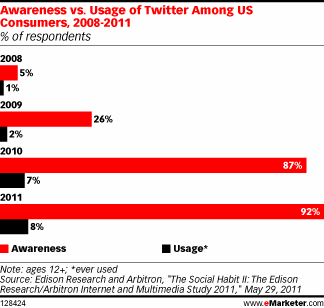
Looking at what might be considered its big brother, or a brother on steroids, we see that 42% of online Americans last year and a projected 57% this year are actively using Facebook.
I can’t use the classic ‘first to market’ explanation to describe why utilization is higher for one than the other. Otherwise, we’d all be on Friendster or My Space.
For Facebook, adoption is awfully close to usage, with a whopping 70% of users logging on daily. They are closing the gap between adoption and utilization – remember it is our position that adoption is pointless without utilization – by being, in social media circles, compelling.
But what makes something ‘compelling’ or what drives utilization? In Facebook’s case I know that I, for one, feel like if I don’t login that I will miss something. I don’t feel that way with Twitter, and apparently I am not alone.
So back to the world of economic needs and improving quality of life – we’re investing in broadband and e-solutions to drive economic efficiencies and create growth opportunities. These include reaching new markets, developing new business models, creating new relationships with partners and clients.
It is our job to make that feeling of ‘missing out’ a tangible, understandable reason to utilize e-solutions to drive prosperity and growth. Our goal is to ‘personalize’ the return on investment to individual businesses, organizations and households.
SNG’s research, including the DEi scorecard does just that, showing your local businesses what they need to do and the applications they should adapt in order to realize cost efficiencies and increase revenues. This helps make sure that your region does not miss out… on its potential, and on opportunities.
e-Solutions Benchmarking (eSB) in Action
We’re often asked, specifically, “How does an eSB help our region make better decisions and guide investment? Below are a few examples of how an eSB has helped other regions…
Scenario 1: If fiber is going to be available to Professional and Technical Service firms in your region (i.e. county or economic development region) and the Executive’s focus (i.e. governor) is best practices in science and technology-based economic development – what services should e-Incubator staff promote in their awareness and outreach efforts to Professional and Technical Service firms?
Finding: The top e-solutions that Professional and Technical Service firms plan to use and need help with when on DSL are:
- Delivering Services and Content Online
- Social Networking
- Website for Organization
- Online Advertising and Promotion
- Rich Media and Content Creation
The difference in utilization between firms that are on DSL versus Fiber is significant across all seventeen (17) key e-solutions. If Professional and Technical Service firms are to be competitive, they will need to understand where they aren’t competitive and provide support and training to quickly and efficiently bridge those gaps.
The next question is to identify the most effective means of getting the required information and skill development to these firms.
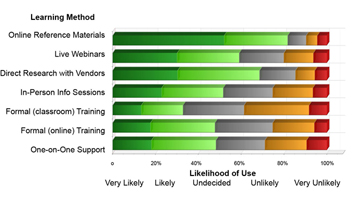 Findings: Self-directed online learning is the preferred method of information and skill development for professional and technical service businesses.
Findings: Self-directed online learning is the preferred method of information and skill development for professional and technical service businesses.
The top three preferred methods are online reference materials, direct research with vendors, and live webinars with experts. The two least preferred methods are formal classroom and formal online courses.
Scenario 2: There is pressure to improve the productivity and quality of public services, while reducing costs. Senior planning staff have been directed to identify areas where public investments in broadband can be used to further these goals.
Findings: Two areas exhibit slow adoption of modern and cost effective delivery methods:
Telehealth services – Only 6.7 of health service providers currently provide telehealth services to patients in their home (with 3.2% adoption in progress and 7.1% planning to adopt). This is in spite of the finding that an average of over 70% of households are currently, planning or willing to explore telehealth services. Increased use of telehealth services have the potential to improve access, while reducing costs and demand in such areas as emergency room visits.
Community services, counselling – Only 13.5% of service providers currently provide remote counselling services through such means as live video. Another 3.5% are in the process of adoption and 9.3% are planning to adopt. This level of adoption is well below levels in mental health centers where tele-psychiatry is a proven and leading edge adopter of tele-health services (respective adoption levels are: 26.5% currently use; 5.9% in progress; 14.7 planning).
Quick Bytes
New Look
Have you visited www.sngroup.com lately? If you have, you may have noticed that the home page has undergone a minor facelift, designed to make navigating our site easier than ever.
e-NC and SNG Study Reveals Types of Home-Based Businesses
Data collected by SNG in North Carolina in 2010 showed that a third (32%) of households had some type of existing home-based business, with another 12% saying that they would start a home-based business within the next year.
This of course points to the fact that bringing robust Internet to the home, affordably, is not just about enabling leisure activity. In fact, regional economic development depends on broadband to the home.
The top home-based businesses by industry sector (NAICS) are: 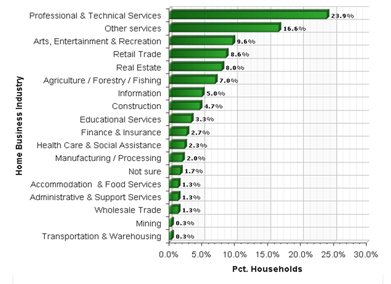
- Professional and Technical Services – 24%
- Arts, Entertainment and Recreation – 10%
- Retail Trade – 9%
- Real Estate – 8%
- Agriculture – 7%
- Information – 5%
- Construction – 5%
Click on chart for a larger version.
So if you’re trying to retain and attract high-paying jobs to your region, ensure that you have a good broadband network and focus on marketing to professionals who can work from home.
Study Reveals Broadband Essential for Economic Development in Europe
According to a study published in May by the McKinsey Global Institute (Internet Matters), Europeans need to be connected if they are to enjoy the significant lifestyle and economic advantages. Not new ground, but what is interesting are some of the findings, directly connecting job creation with broadband, including:
- The Internet generated 21 per cent of GDP growth in the last 5 years in mature countries
- 2.6 jobs are created for every job lost due to the transition to the online economy
- Of the individuals and SMEs who are heavy users of web technology, they are growing and exporting twice as much as others.
Read more about the study by clicking here.
We’re often asked, specifically, “How does an eSB help our region make better decisions and guide investment? Below are a few examples of how an eSB has helped other regions…
Scenario 1: If fiber is going to be available to Professional and Technical Service firms in your region (i.e. county or economic development region) and the Executive’s focus (i.e. governor) is best practices in science and technology-based economic development – what services should e-Incubator staff promote in their awareness and outreach efforts to Professional and Technical Service firms?
Finding: The top e-solutions that Professional and Technical Service firms plan to use and need help with when on DSL are:
- Delivering Services and Content Online
- Social Networking
- Website for Organization
- Online Advertising and Promotion
- Rich Media and Content Creation
The difference in utilization between firms that are on DSL versus Fiber is significant across all seventeen (17) key e-solutions. If Professional and Technical Service firms are to be competitive, they will need to understand where they aren’t competitive and provide support and training to quickly and efficiently bridge those gaps.
The next question is to identify the most effective means of getting the required information and skill development to these firms.
 Findings: Self-directed online learning is the preferred method of information and skill development for professional and technical service businesses.
Findings: Self-directed online learning is the preferred method of information and skill development for professional and technical service businesses.
The top three preferred methods are online reference materials, direct research with vendors, and live webinars with experts. The two least preferred methods are formal classroom and formal online courses.
Scenario 2: There is pressure to improve the productivity and quality of public services, while reducing costs. Senior planning staff have been directed to identify areas where public investments in broadband can be used to further these goals.
Findings: Two areas exhibit slow adoption of modern and cost effective delivery methods:
Telehealth services – Only 6.7 of health service providers currently provide telehealth services to patients in their home (with 3.2% adoption in progress and 7.1% planning to adopt). This is in spite of the finding that an average of over 70% of households are currently, planning or willing to explore telehealth services. Increased use of telehealth services have the potential to improve access, while reducing costs and demand in such areas as emergency room visits.
Community services, counselling – Only 13.5% of service providers currently provide remote counselling services through such means as live video. Another 3.5% are in the process of adoption and 9.3% are planning to adopt. This level of adoption is well below levels in mental health centers where tele-psychiatry is a proven and leading edge adopter of tele-health services (respective adoption levels are: 26.5% currently use; 5.9% in progress; 14.7 planning).



